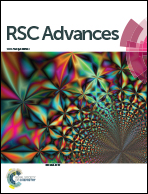Removal of disperse violet 28 from water using self-assembled organo-layered double hydroxides through a one-step process
Abstract
A simple, one-step process including the self-assembly of organo-layered double hydroxides and removal of disperse dye simultaneously has been proposed. This one-step process can hopefully be applied for dye effluents removal due to its low operation cost and simplified process compared with a traditional organo-layered double hydroxides process. Here, the self-assembly of organo-layered double hydroxides was realized by adding both raw layered double hydroxides and the anionic surfactant sodium dodecylsulfate into wastewater, and then the one-step process was applied to remove disperse violet 28 from dyeing wastewater. The results showed a higher removal efficiency of disperse violet 28 in this one-step process than in a traditional organo-layered double hydroxide process because cooperative removal and synergism between the surfactant and disperse violet 28 in solution occurred to a large extent. The adsorption isotherm data could be described by the linear model, indicating a partitioning adsorption process. The adsorption kinetics was found to be well presented by the pseudo-second-order model, and the high activation energy (56.64 kJ mol−1) indicated that the adsorption was mainly a chemical process.


 Please wait while we load your content...
Please wait while we load your content...